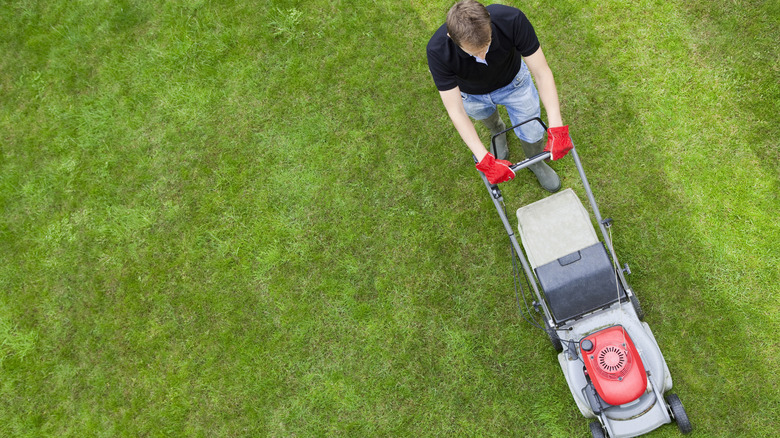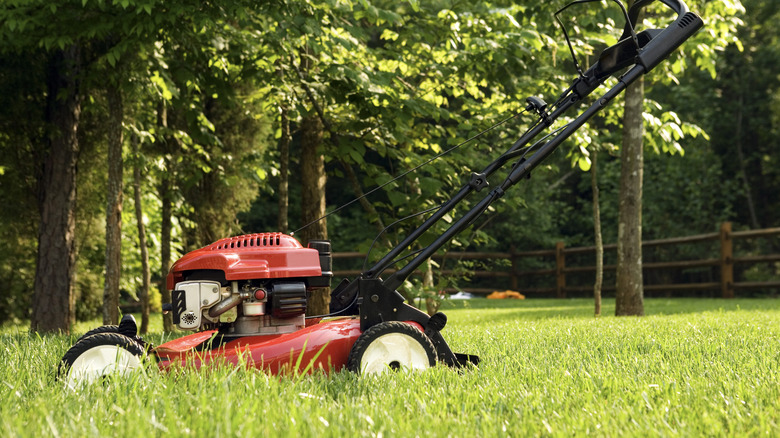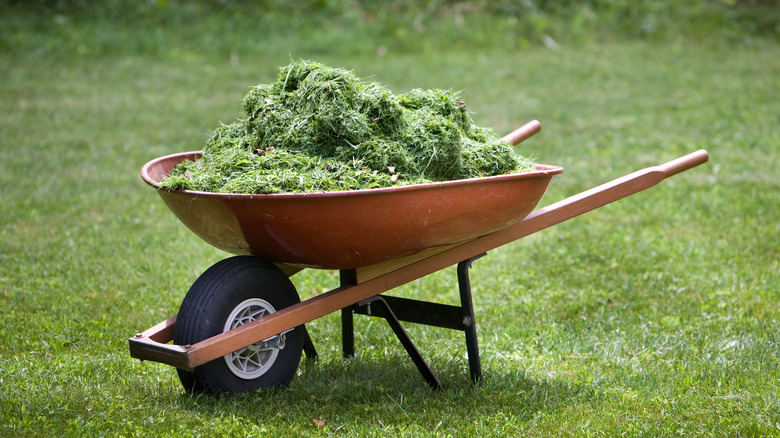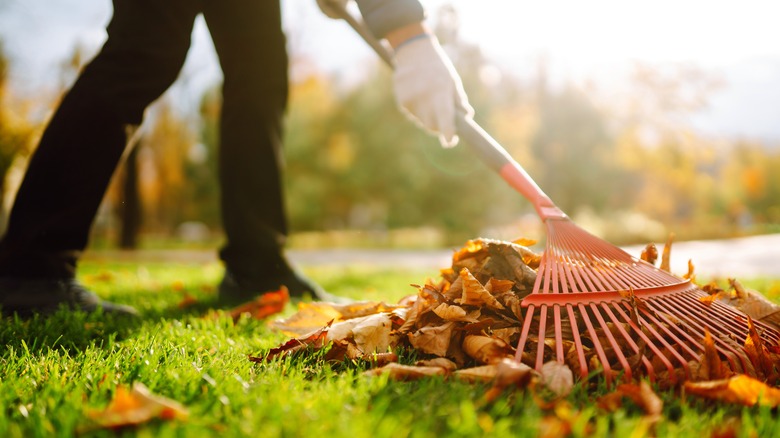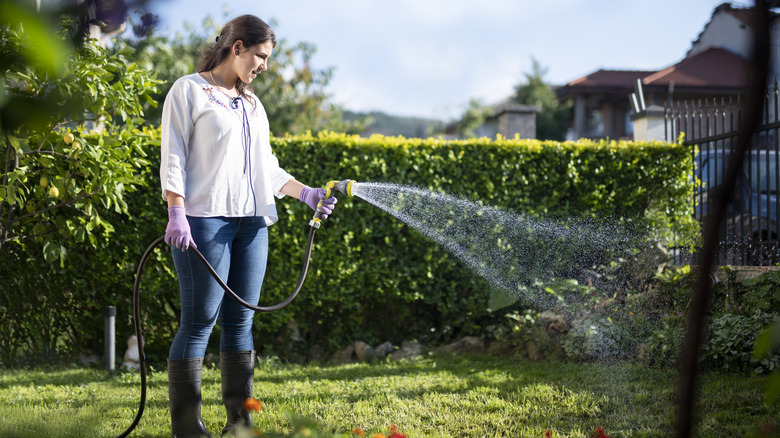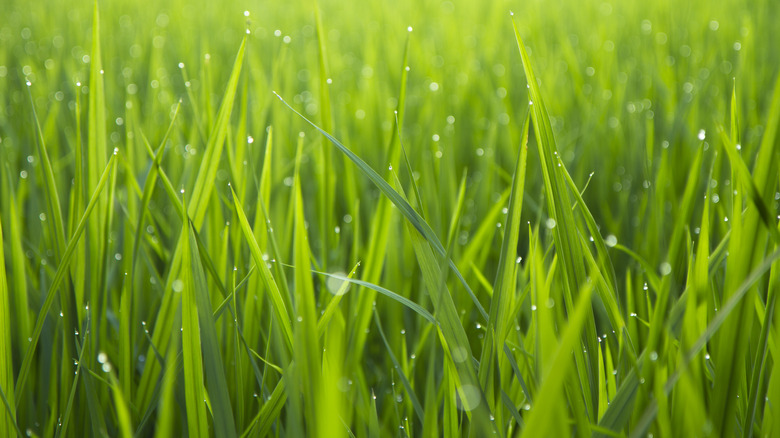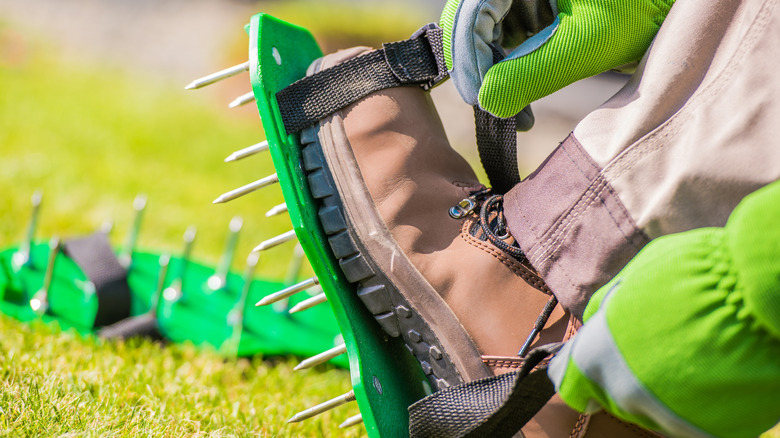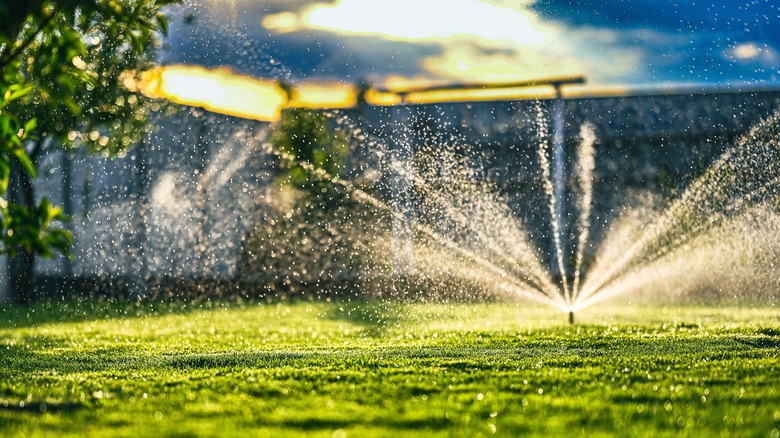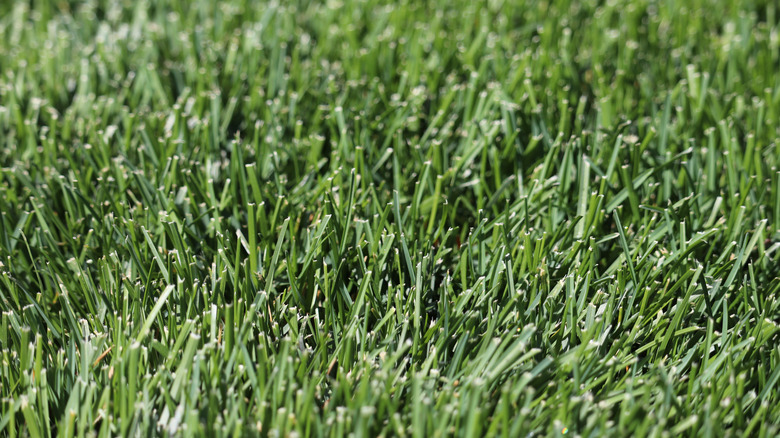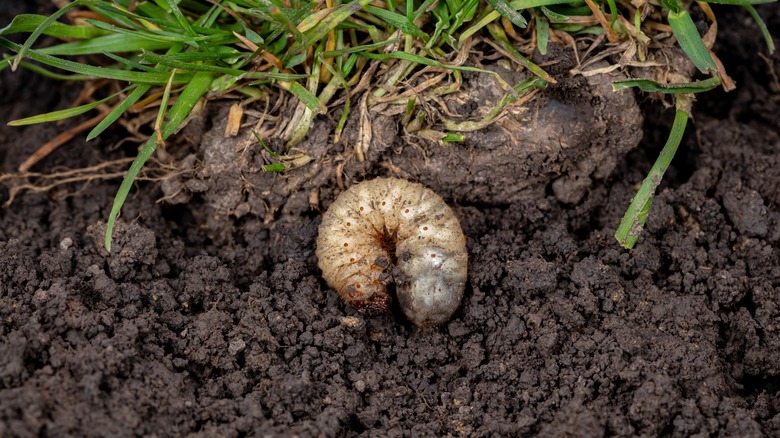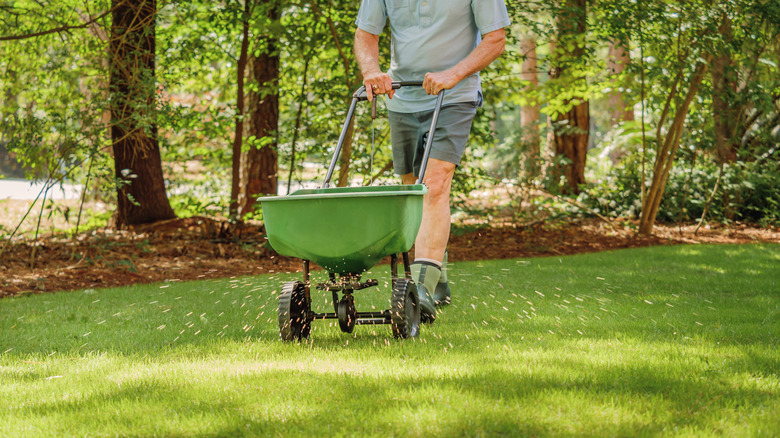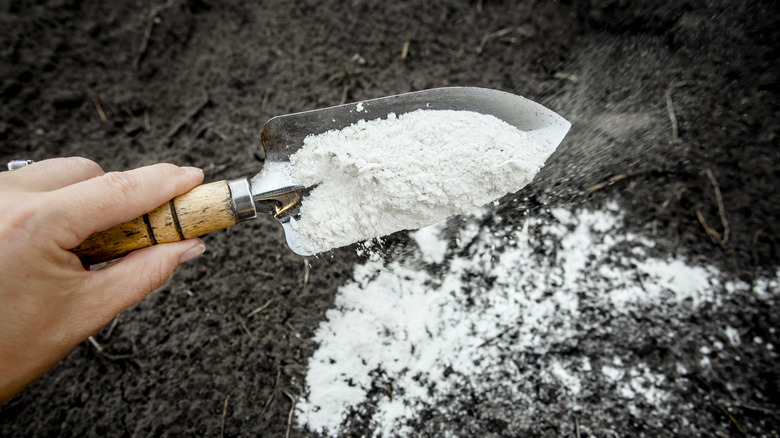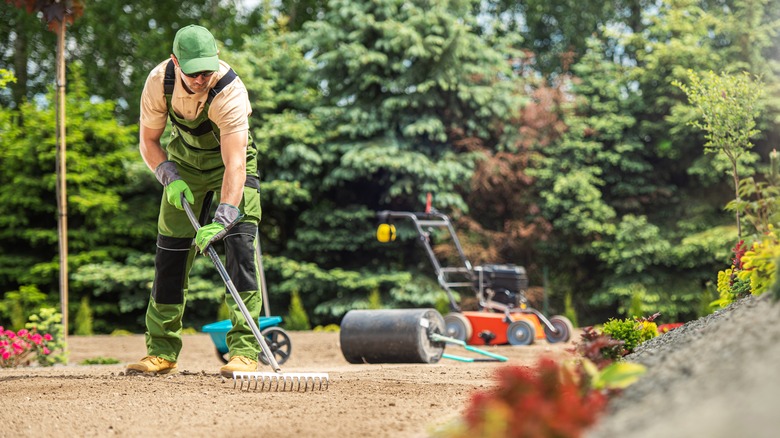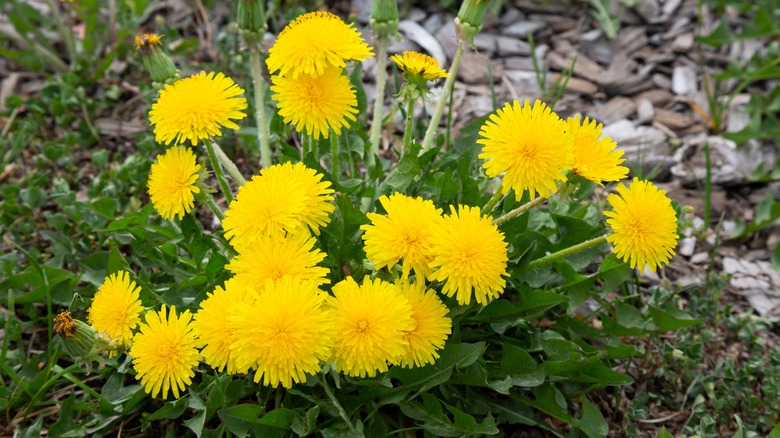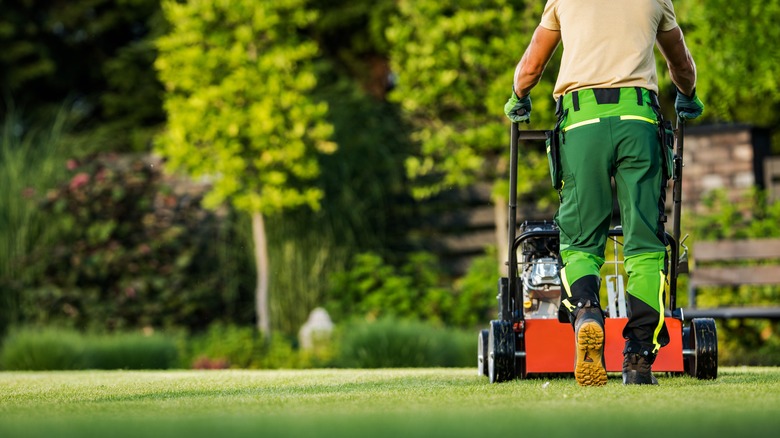Lawncare Myths You Can Stop Believing
Everyone wants their lawn to be three things. They want it to be beautiful, they want it to be shimmering green, and they want it problem-free. However, you can't just stare at your lawn and will it into a state of beauty. You have to work at it in order to get it the way you want. With work comes learning. And when it comes to lawns, there is a lot of information out there. Some of it is good. And some of it is, well, you'll see.
In spite of the literal library of lawncare available to everyone via the internet, there are nevertheless a good amount of myths that have stuck around like a resilient weed. As such, it can often be difficult to separate lawncare myths from reality. We all want to take care of our lawns, but the ways we go about doing so may be causing our lawns more harm than good.
You'll no doubt recognize a lot of these myths. You may even be doing a few of them. Well, it's time you stopped believing these 15 lawncare myths because they are, in all actuality, totally made up.
Cutting it short means less mowing
There is a certain amount of logic behind this myth. "If I cut my lawn as short as possible," you think, "I won't have to cut it nearly as often!" This statement is what philosophers call a dialetheia, meaning that it is both true and false. It's true: you won't have to mow your lawn as often if you cut it really short. But, instead of the grass taking a little longer to grow back, it might not grow back at all.
Grass is a living plant that needs to photosynthesize in order to survive. It has a root system, and the blades that grow feed the roots by taking in sunlight. The longer the blades of grass are, the more surface area is exposed, which allows for more sun to be soaked in. The more sun grass is able to take in, the healthier the root system will be.
By cutting the grass too short, you are essentially cutting off the grass' main food supply, making it harder for the grass to grow and potentially causing it to die. A good rule to follow is thus: a lawn mowed to 3 inches in height will need to be mowed every seven days or once weekly. This allows for thick, healthy turf with minimal inputs. A healthy lawn needn't be mowed to within a literal inch of its life.
Grass clippings create thatch
It's a commonly held misconception that you need to bag all of your grass clippings and remove them from your yard as a method of preventing thatching. Thatch occurs when grass becomes so covered by debris that everything beneath said debris withers and dies. However, as it turns out, thatch is mostly composed of roots, rhizomes, twigs, stems, and stolons – not grass clippings (via Good's Tree and Lawn Care).
Grass clippings are made primarily of water. They will very easily break down and return their nutrients to the grass if properly mulched. If the trimmings are all bunched up into a big pile, they are going to take longer to break down. This is the only instance where they could be considered to have thatching properties. However, unless the grass you're mowing is really wet, your lawn mower will do the job of mulching the clippings right back into the lawn.
If you have a large yard and find yourself with excessive clippings, mix them into your compost. They are naturally high in nitrogen and can really get your compost cooking. If you have chickens, they will consider a large pile of fresh lawn trimmings to be a veritable feast, so long as they aren't too long. These are great alternative ways to up-cycle your grass clippings, and they all go back towards benefiting your yard's ecosystem.
Fallen leaves will smother your grass
Similar to grass clippings, fallen leaves are not the evil you think that they are. They will actually do your lawn some good. Apart from their stems, leaves are very similar in composition to grass clippings. Remember how we said grass blades act as leaves for the roots? The same is true for proper tree leaves.
When properly mulched, roughly to the size of a dime, leaves will very easily break down and return their nutrients to the soil. They can also add some much-needed moisture to a lawn that could be starved for thirst, whether via the weather or from you cutting the grass too low. A thin bed of leaves on your lawn is not going to do it any harm. The problems arise when the leaf pile gets too thick.
If the leaves have collected to the point where you cannot see your grass underneath, then they are choking out your grass and need to be raked away and mulched. Light is unable to penetrate the leaf blanket, therefore rendering the grass unable to grow. Plus, the bottom layer of leaves will begin to decay and turn to leaf mold, which, in turn, will feed the soil beneath. Unfortunately, the grass will die, making leaf blankets great for gardens, but terrible for lawns.
Daily watering
Watering the lawn daily is an American pastime. It's something we all watched our parents and neighbors do while we were growing up. We figured it was just a ritual of suburban life that needed to be observed and copied when we reached adulthood. We're telling you now, however, that you were sold a false bag of goods. Don't water your lawn every day. It does not need it.
Much in the same way people think that they need to water their gardens daily, so too do folks believe that they need to water their lawns for 15 minutes every single day. This is not nearly enough time for the water to reach the roots, making it totally counterproductive and somewhat unnecessary. Your lawn only needs 1 to 1.5 inches of water in a given week in order to survive.
Obviously, if you're experiencing a dry season, watering is going to be necessary to keep your yard from drying out. However, it is going to take a lot longer than 15 minutes to create 1.5 inches of water in a single watering. In this instance, watering twice weekly for over an hour is totally acceptable in order to keep your lawn looking as fresh as possible. Any more than this is completely unnecessary and may even be banned depending on town regulations.
Watering at any given time of the day
Even if you aren't watering your lawn daily, you could be watering it at the wrong time of day. You don't want to begin watering your lawn well into the morning, just as you don't want to be watering it at night. Watering past dark is a dangerous mistake. The change in temperature from day to night will cause condensation on the grass, which, when combined with evening watering, leads to even more moisture, which leads to funguses, bacteria, and mildew.
If you're watering in the middle of the day, when the sun is blazing down on your lawn, you're wasting water. The water you place on the lawn is not going to have any time to actually reach the soil, which is where it is most needed. The sun will totally evaporate the water before it has a chance to get where it is going.
You want to be watering your lawn in the earlier morning hours, sometime between 5 a.m. and 10 a.m. The dew will be drying off, so there isn't any excess water. Yet, the sun is not high enough to be so blazing hot that the water is evaporating on contact. You'll be able to get a good amount of water into the soil while having some warm sun to feed the grass. There really is no better window.
Wearing spiked shoes to aerate soil
There is a notion out there that your soil needs to be constantly aerated in order for it to remain healthy and not become compacted. First and foremost, if the earth beneath your feet is compacted, you aren't going to be seeing much, if any, grass growth. It is very difficult for grass to grow and thrive in compacted soil. Therefore, if you've already got grass, chances are that your soil is decently aerated. For small areas of compaction, you could use a pitchfork and poke holes. For larger areas, it's best to hire pros who use machines.
What you shouldn't do is walk around with spiked shoes. This is an answer that folks seem to think works, but their efforts are fueled by irony. The fact of the matter is that walking through your lawn with spikes on your feet is actually going to create compaction, not relieve it. The pressure exerted by your foot pressing into the dirt is going to negate any effect the spikes may have on the soil. You're just pushing down on the dirt instead of making it loose and allowing it to breathe properly.
Plus, there is the fact that any aeration you do get will not be enough to fix the compaction. At least 5% of the soil's surface will need to be aerated in order to do this. Spiked shoes will not get you even close to that amount.
Hose vs. irrigation system
In terms of upfront cost, many people think that a standard garden hose and a small sprinkler are going to be more economically efficient than a professionally installed irrigation system. This could be true if you have a postcard for a lawn. However, seeing as the national average lawn size is half an acre, a standard hose and sprinkler are not going to be as efficient as you think they are.
You are actually going to end up using a lot more water than you think just by continuing to use your hose. A good irrigation system, while obviously more expensive than a garden hose, is actually going to end up saving you a lot in terms of overall cost and amount of water. Saving water is essential; regardless of whether you pay for city water or have a well, you need to think about keeping it full.
Saving water isn't just good when it comes to expenses. It can also be beneficial if your town institutes a water restriction. You can adjust your irrigation system to expel the amount of water allowed. If you use a hose, you're left to estimate, meaning you could easily exceed the restriction, which could get you in a bit of trouble. It's up to you, but if you've got a bigger lawn, it's probably worth it to get an irrigation system.
All grass is the same
When you look closely enough, you'll see that not all grasses are the same. In fact, there are several different types of lawn grasses that are grown all throughout the United States. There's Kentucky bluegrass, bermudagrass, bentgrass, fine fescue, ryegrass, St. Augustine, zoysiagrass, and many others. Each flourishes in different environments and, therefore, requires different types of care in order to thrive.
Let's take Kentucky bluegrass as an example. This is one of the most popular types of grasses in the northern United States. It thrives in relatively cool climates and requires average watering in order to stay soft and build thick turf. It's relatively low maintenance. Bermudagrass, on the other hand, requires a lot of maintenance. Watering, mowing, and fertilizing are all important in order to keep this grass as green and shimmering as possible. Bermudagrass thrives in warmer climates and is a favorite among Southerners as a grass for golf courses.
You can identify your grass either by referencing guides or talking to a landscaping professional. Once you put in some study, you'll be able to see where they differ in terms of blade length, thickness, color, and texture. Now that you've identified your particular variety of grass, you'll be better able to take care of it.
One grub equals many grubs
Grubs are the enemies of lawns. Upon sighting just one, most of us will instinctively think that there must be more burrowing below the surface. While this can be the case in certain situations, it is hardly always the case. Sure, grub infestations can absolutely devastate a yard. However, just because you've spotted one does not mean that there are hundreds more. There is an easy way to check if you have an infestation or not.
When you spot a grub, dig a small test hole, only a few inches square, and see if there are more in the ground. Obviously, if the hole is teaming with too many grubs to grubs, you've got a problem on your hands. However, if there are less than 5 grubs poking around in the dirt, you're likely in the clear.
Now, the presence of grubs also begs the question: are there moles in my yard too? While it's true that an unkempt and grub-filled yard is one of the main mistakes that attract moles to a yard, if you've only got that small number of grubs, it's not nearly enough to tempt them. Plus, you will see other signs, such as molehills and trenches in your garden, that will alert you to their presence. One grub does not make an infestation of any kind.
Fertilizing is bad for the environment
This one will yield a mixed reaction from folks. On the one hand, yes, consistently fertilizing a yard with every chemical under the sun is probably going to have a negative impact on the surrounding environment. After all, if a fertilizer is not safe for people and pets to walk on after it is spread, why on earth would it be okay to use it in the first place? However, there are some theories that suggest otherwise.
Natural Green Systems states that the roots system and the grass itself are sufficient at filtering out any types of bad things that would make their way into city waters, which will then make their way out into the area's native waters. However, according to Occupational Health and Safety, fertilizing with chemicals can cause damage, over time, to the ground water. So, you should probably seek an alternative.
There are so many all-natural or purely organic fertilizers that are going to be much better for your lawn and the surrounding environment in the long term than any chemicals are going to be. Ground shells, bone meal, all-natural compost, and animal manure are all going to get the job done just as well and with fewer negative side effects than with chemical stuff. So no, depending on what you're using, fertilizing is not bad for the environment.
Your lawn needs lime
When it comes to the chemistry of lawncare, Ph levels play an important role in getting your lawn to look gorgeous and be healthy. According to Earth Magazine, lime, an inorganic mineral composed primarily of calcium hydroxide, is used in a number of different fertilizers but is also used in its pure form as a way of balancing the Ph levels in a home lawn. However, the amount that is required to feed your lawn is not as high as people think it is.
Lots of homeowners believe that constant, thick applications of lime to their yards are going to help keep them in excellent health. They think that it needs to be constantly applied to the soil in the same way a hayfield needs to be constantly limed. This is overkill, however. Hay and other agricultural fields need to be limed heavily to counteract the acidity of the fertilizers being used to encourage tall grass development. In a normal lawn, you don't need to be fertilizing nearly as much, and subsequently don't need to be liming nearly as much.
This isn't to say that your lawn couldn't benefit from some lime, but you will need to get a soil test done first in order to see whether or not the pH levels indicate the need for a balancer. If that is the case, then you can certainly apply lime to your lawn.
Mowing in the morning
While it is true that you don't want to be mowing your lawn at high noon under the blazing sun, you also don't want to be mowing too early in the day before the grass has had time to dry. Wet grass is incredibly difficult to mow and can cause a lot of problems that could have easily been prevented with patience.
When grass is dry, it's much easier to cut because there is no moisture around to cause the trimmings to cling together. Much like water brings flour together to form a dough, so too does water on grass create clumps. These clumps will begin to clog up your lawnmower blades, causing uneven trimming, and could potentially leave large clumps of thick, wet mush in your yard. Plus, if your mower gets clogged, you'll then need to wait a while in order to safely unclog it. Don't be sticking your hand anywhere near blades that are still hot or if the mower engine is running.
Instead, all you need to do is wait a few hours for the sun to do its job and dry out the grass. If you don't want to mow at noon, wait until you get home from work or mow the lawn just after dinner as the sun starts to go down. The dew won't have formed yet, and it won't be so sweltering that you will potentially find yourself dehydrated and exhausted. Those two things are never a good combination.
Seeding or fertilizing only in the spring
Spring is an amazing time for your lawn. After several long months of dormancy, the snow is finally melting and your lawn is getting the deep hydration it needs to begin growing again. It's a fantastic time of year for you to seed and fertilize your lawn, as the growth is just beginning to take hold. However, there is a general myth out there that states that spring is the only time of year that you need to be seeding and fertilizing your lawn. This simply is not the case.
Remember, seeding and fertilizing are actually two different things. Seeding is the introduction of new grass seeds into the soil, while fertilizing is the process of feeding the lawn with nutrients. The latter can be done throughout the season, as the yard will need to be consistently fed in order to maintain proper health and productivity. When to seed depends more on your climate zone and the type of grass you're growing.
Remember, not all grass is the same. Some actually are best seeded in the fall so that they overwinter and are already ready to grow come the fertile spring. Tall fescue is a great example of a grass that prefers fall seeding, as the seeds could very easily become parched in the heat of a spring or summer day. The point is, get to know your grass. Spring isn't the be-all-end-all just because things start growing.
Removing dandelions in the spring
Dandelions are one of those weeds that can be downright difficult to control. Difficult still is the attempt to remove the seed source of these perennial weeds. It is a fruitless affair. Not only do the seeds spread with a good wind, but the taproots of the dandelion can extend as deep as 8 inches into the earth. Plus, there are just far too many of them to make that job even remotely possible, especially in the spring.
Removing dandelions in the spring right when they flower and before they have a chance to become tufty white lawn lollipops might seem like the right option. However, doing this doesn't actually deter them in the way you might think. Yes, you're taking them away, but you are also removing a vital part of the ecology of your lawn. Dandelions may be a broadleaf weed, but they still feed birds, and people for that matter.
What you should be doing instead is focusing on building up your turf and making it incredibly strong. The thicker and stronger the turf, the harder it will be for weeds like dandelions to break through. So, whatever methods you have that work for the health of your lawn, keep it up. The healthier the lawn, the less you'll have to worry about weeds and such.
Not considering hiring pros
If everything we've just listed is more effort than is worth your time, don't worry. You don't need to tackle all of this yourself. While there are many homeowners who take pride in their DIY lawns, there is an equal number of people who cannot stand the idea of working in their yards. Regardless of what camp you are in, one mistake many people make is not hiring pros.
Not only can professional lawncare companies save you time and aggravation, but they could save you a decent bit of money, too. Think about it: if you have someone come in and get the job done right the first time, that saves you the time and resources you would have spent trying to do things yourself. Professional landscapers can mow, seed, fertilize, and otherwise properly maintain your lawn and surrounding landscaping. Most are very good at doing it; otherwise, they wouldn't be in business.
We're sure there are many more lawn myths out there that people are still believing, but if we listed them all, it would stretch for miles. These 15 myths that we've listed are the most common that you'll find people, including yourself, believing in. If you have believed any one of these myths throughout your life, stop. You don't need to go on believing anymore.
